CBT Counselling Report: Principles, Focus, and Humanistic Psychology
VerifiedAdded on 2020/07/23
|12
|3563
|46
Report
AI Summary
This report provides a comprehensive overview of Cognitive Behavioural Therapy (CBT) in a counselling context. It begins by outlining the key therapeutic principles that underpin CBT, emphasizing the interconnectedness of thoughts, perceptions, feelings, and actions, and the role of negative thinking in perpetuating problems. The report then details the main areas of focus within CBT, utilizing a five-part model including situation, thoughts, emotions, physical sensations, and behaviors. It also explores the 'third wave' of CBT, as defined by Hayes, and its emphasis on improving the quality and quantity of tasks. Furthermore, the report analyzes the support that CBT concepts and abilities provide to therapists, highlighting the importance of therapeutic alliance, collaboration, and active participation. The report also includes a discussion on the postulates described in humanistic psychology, with a focus on the integration of body, mind, feeling, and ability, and the importance of personal interaction. The report emphasizes the effectiveness of CBT for various mental health issues, including depression and personality disorders, and its role in empowering patients and enhancing their skills.

Counselling
Paraphrase This Document
Need a fresh take? Get an instant paraphrase of this document with our AI Paraphraser
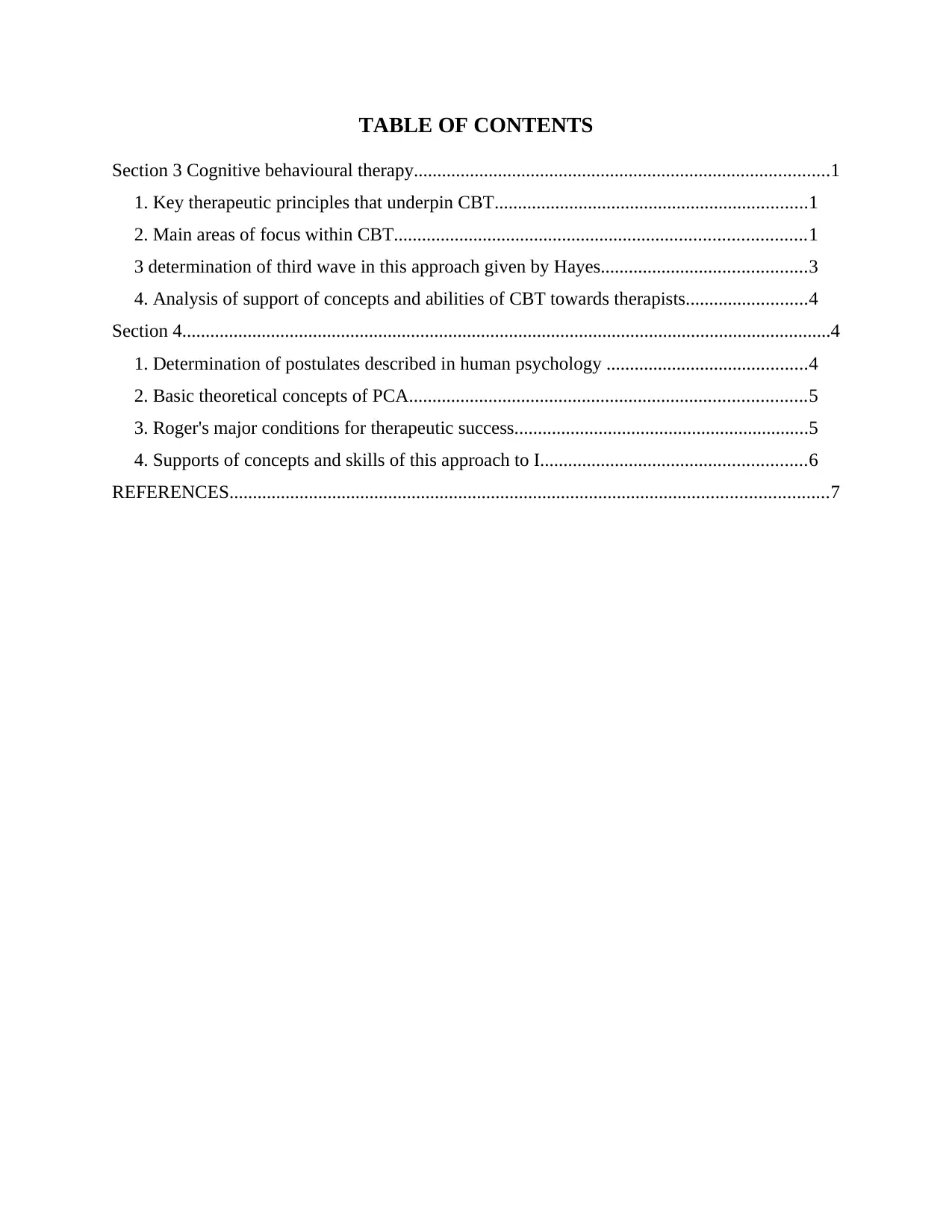
TABLE OF CONTENTS
Section 3 Cognitive behavioural therapy.........................................................................................1
1. Key therapeutic principles that underpin CBT...................................................................1
2. Main areas of focus within CBT........................................................................................1
3 determination of third wave in this approach given by Hayes............................................3
4. Analysis of support of concepts and abilities of CBT towards therapists..........................4
Section 4...........................................................................................................................................4
1. Determination of postulates described in human psychology ...........................................4
2. Basic theoretical concepts of PCA.....................................................................................5
3. Roger's major conditions for therapeutic success...............................................................5
4. Supports of concepts and skills of this approach to I.........................................................6
REFERENCES................................................................................................................................7
Section 3 Cognitive behavioural therapy.........................................................................................1
1. Key therapeutic principles that underpin CBT...................................................................1
2. Main areas of focus within CBT........................................................................................1
3 determination of third wave in this approach given by Hayes............................................3
4. Analysis of support of concepts and abilities of CBT towards therapists..........................4
Section 4...........................................................................................................................................4
1. Determination of postulates described in human psychology ...........................................4
2. Basic theoretical concepts of PCA.....................................................................................5
3. Roger's major conditions for therapeutic success...............................................................5
4. Supports of concepts and skills of this approach to I.........................................................6
REFERENCES................................................................................................................................7
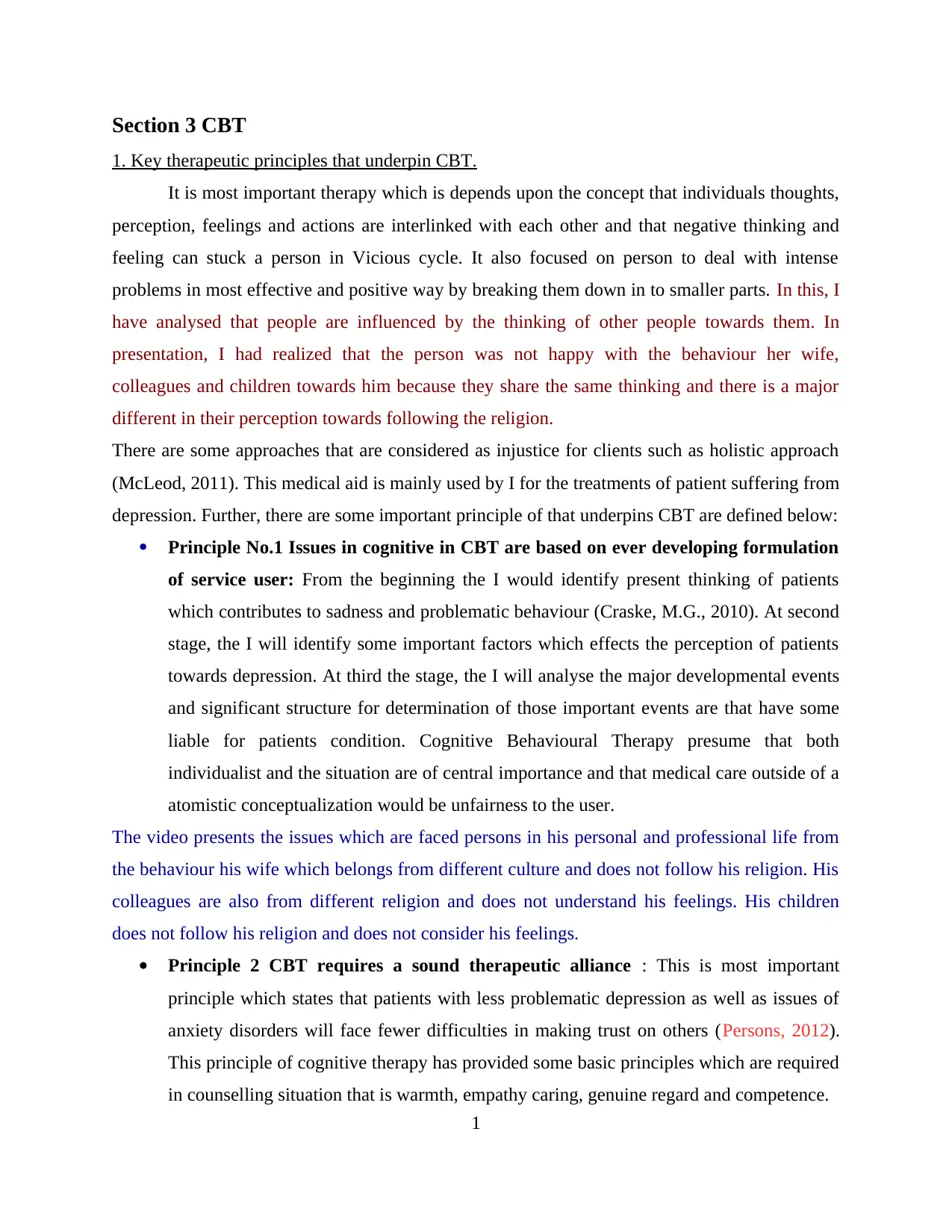
Section 3 CBT
1. Key therapeutic principles that underpin CBT.
It is most important therapy which is depends upon the concept that individuals thoughts,
perception, feelings and actions are interlinked with each other and that negative thinking and
feeling can stuck a person in Vicious cycle. It also focused on person to deal with intense
problems in most effective and positive way by breaking them down in to smaller parts. In this, I
have analysed that people are influenced by the thinking of other people towards them. In
presentation, I had realized that the person was not happy with the behaviour her wife,
colleagues and children towards him because they share the same thinking and there is a major
different in their perception towards following the religion.
There are some approaches that are considered as injustice for clients such as holistic approach
(McLeod, 2011). This medical aid is mainly used by I for the treatments of patient suffering from
depression. Further, there are some important principle of that underpins CBT are defined below:
Principle No.1 Issues in cognitive in CBT are based on ever developing formulation
of service user: From the beginning the I would identify present thinking of patients
which contributes to sadness and problematic behaviour (Craske, M.G., 2010). At second
stage, the I will identify some important factors which effects the perception of patients
towards depression. At third the stage, the I will analyse the major developmental events
and significant structure for determination of those important events are that have some
liable for patients condition. Cognitive Behavioural Therapy presume that both
individualist and the situation are of central importance and that medical care outside of a
atomistic conceptualization would be unfairness to the user.
The video presents the issues which are faced persons in his personal and professional life from
the behaviour his wife which belongs from different culture and does not follow his religion. His
colleagues are also from different religion and does not understand his feelings. His children
does not follow his religion and does not consider his feelings.
Principle 2 CBT requires a sound therapeutic alliance : This is most important
principle which states that patients with less problematic depression as well as issues of
anxiety disorders will face fewer difficulties in making trust on others (Persons, 2012).
This principle of cognitive therapy has provided some basic principles which are required
in counselling situation that is warmth, empathy caring, genuine regard and competence.
1
1. Key therapeutic principles that underpin CBT.
It is most important therapy which is depends upon the concept that individuals thoughts,
perception, feelings and actions are interlinked with each other and that negative thinking and
feeling can stuck a person in Vicious cycle. It also focused on person to deal with intense
problems in most effective and positive way by breaking them down in to smaller parts. In this, I
have analysed that people are influenced by the thinking of other people towards them. In
presentation, I had realized that the person was not happy with the behaviour her wife,
colleagues and children towards him because they share the same thinking and there is a major
different in their perception towards following the religion.
There are some approaches that are considered as injustice for clients such as holistic approach
(McLeod, 2011). This medical aid is mainly used by I for the treatments of patient suffering from
depression. Further, there are some important principle of that underpins CBT are defined below:
Principle No.1 Issues in cognitive in CBT are based on ever developing formulation
of service user: From the beginning the I would identify present thinking of patients
which contributes to sadness and problematic behaviour (Craske, M.G., 2010). At second
stage, the I will identify some important factors which effects the perception of patients
towards depression. At third the stage, the I will analyse the major developmental events
and significant structure for determination of those important events are that have some
liable for patients condition. Cognitive Behavioural Therapy presume that both
individualist and the situation are of central importance and that medical care outside of a
atomistic conceptualization would be unfairness to the user.
The video presents the issues which are faced persons in his personal and professional life from
the behaviour his wife which belongs from different culture and does not follow his religion. His
colleagues are also from different religion and does not understand his feelings. His children
does not follow his religion and does not consider his feelings.
Principle 2 CBT requires a sound therapeutic alliance : This is most important
principle which states that patients with less problematic depression as well as issues of
anxiety disorders will face fewer difficulties in making trust on others (Persons, 2012).
This principle of cognitive therapy has provided some basic principles which are required
in counselling situation that is warmth, empathy caring, genuine regard and competence.
1
⊘ This is a preview!⊘
Do you want full access?
Subscribe today to unlock all pages.

Trusted by 1+ million students worldwide
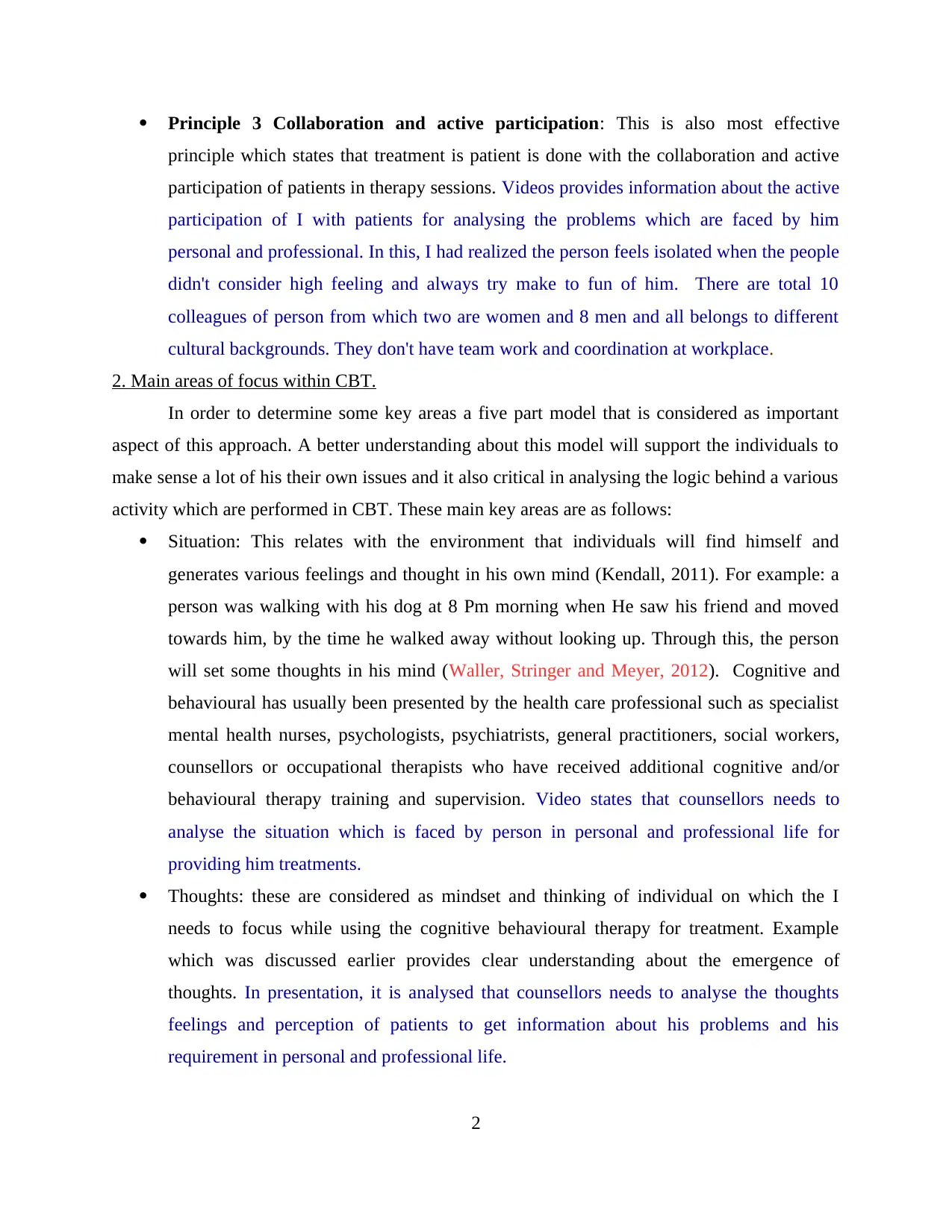
Principle 3 Collaboration and active participation: This is also most effective
principle which states that treatment is patient is done with the collaboration and active
participation of patients in therapy sessions. Videos provides information about the active
participation of I with patients for analysing the problems which are faced by him
personal and professional. In this, I had realized the person feels isolated when the people
didn't consider high feeling and always try make to fun of him. There are total 10
colleagues of person from which two are women and 8 men and all belongs to different
cultural backgrounds. They don't have team work and coordination at workplace.
2. Main areas of focus within CBT.
In order to determine some key areas a five part model that is considered as important
aspect of this approach. A better understanding about this model will support the individuals to
make sense a lot of his their own issues and it also critical in analysing the logic behind a various
activity which are performed in CBT. These main key areas are as follows:
Situation: This relates with the environment that individuals will find himself and
generates various feelings and thought in his own mind (Kendall, 2011). For example: a
person was walking with his dog at 8 Pm morning when He saw his friend and moved
towards him, by the time he walked away without looking up. Through this, the person
will set some thoughts in his mind (Waller, Stringer and Meyer, 2012). Cognitive and
behavioural has usually been presented by the health care professional such as specialist
mental health nurses, psychologists, psychiatrists, general practitioners, social workers,
counsellors or occupational therapists who have received additional cognitive and/or
behavioural therapy training and supervision. Video states that counsellors needs to
analyse the situation which is faced by person in personal and professional life for
providing him treatments.
Thoughts: these are considered as mindset and thinking of individual on which the I
needs to focus while using the cognitive behavioural therapy for treatment. Example
which was discussed earlier provides clear understanding about the emergence of
thoughts. In presentation, it is analysed that counsellors needs to analyse the thoughts
feelings and perception of patients to get information about his problems and his
requirement in personal and professional life.
2
principle which states that treatment is patient is done with the collaboration and active
participation of patients in therapy sessions. Videos provides information about the active
participation of I with patients for analysing the problems which are faced by him
personal and professional. In this, I had realized the person feels isolated when the people
didn't consider high feeling and always try make to fun of him. There are total 10
colleagues of person from which two are women and 8 men and all belongs to different
cultural backgrounds. They don't have team work and coordination at workplace.
2. Main areas of focus within CBT.
In order to determine some key areas a five part model that is considered as important
aspect of this approach. A better understanding about this model will support the individuals to
make sense a lot of his their own issues and it also critical in analysing the logic behind a various
activity which are performed in CBT. These main key areas are as follows:
Situation: This relates with the environment that individuals will find himself and
generates various feelings and thought in his own mind (Kendall, 2011). For example: a
person was walking with his dog at 8 Pm morning when He saw his friend and moved
towards him, by the time he walked away without looking up. Through this, the person
will set some thoughts in his mind (Waller, Stringer and Meyer, 2012). Cognitive and
behavioural has usually been presented by the health care professional such as specialist
mental health nurses, psychologists, psychiatrists, general practitioners, social workers,
counsellors or occupational therapists who have received additional cognitive and/or
behavioural therapy training and supervision. Video states that counsellors needs to
analyse the situation which is faced by person in personal and professional life for
providing him treatments.
Thoughts: these are considered as mindset and thinking of individual on which the I
needs to focus while using the cognitive behavioural therapy for treatment. Example
which was discussed earlier provides clear understanding about the emergence of
thoughts. In presentation, it is analysed that counsellors needs to analyse the thoughts
feelings and perception of patients to get information about his problems and his
requirement in personal and professional life.
2
Paraphrase This Document
Need a fresh take? Get an instant paraphrase of this document with our AI Paraphraser
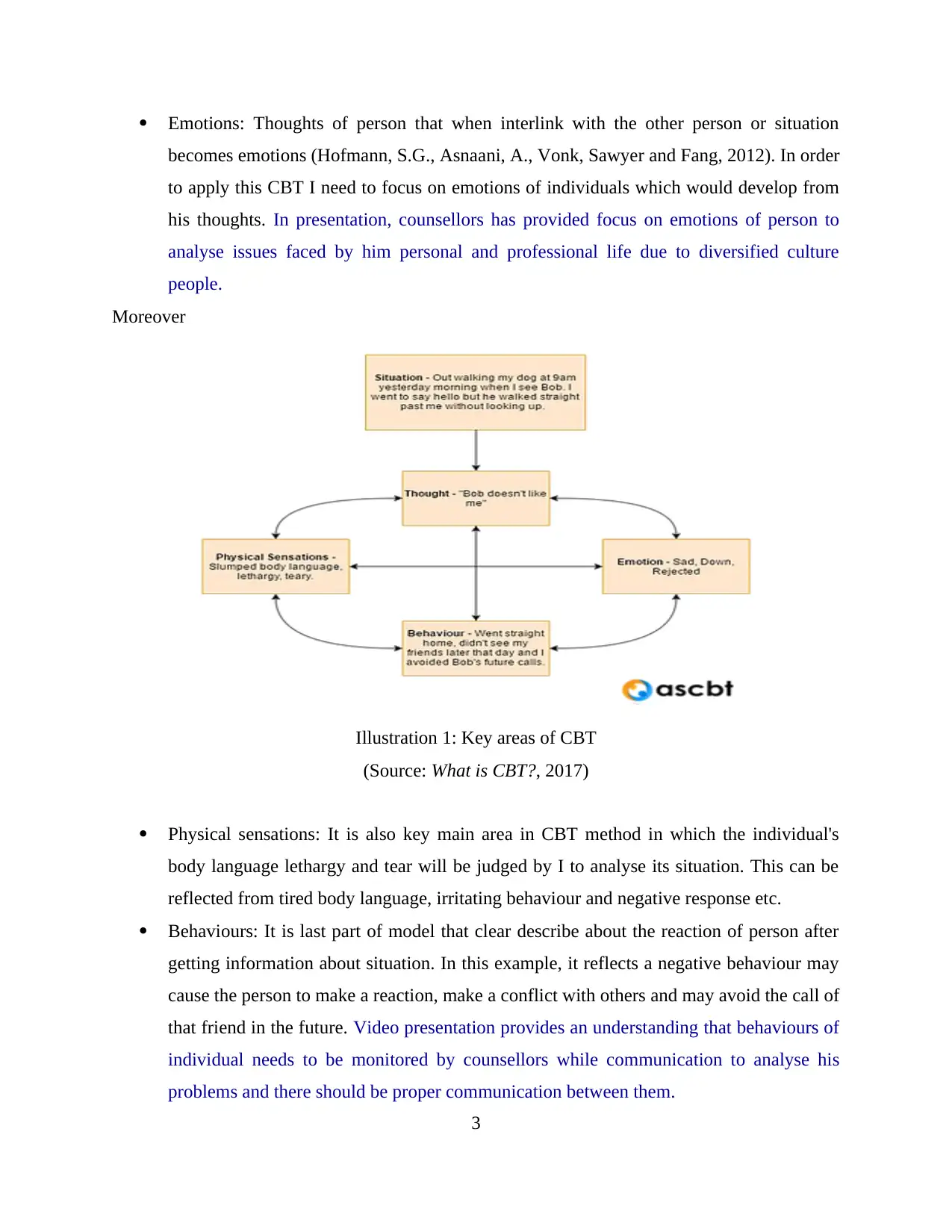
Emotions: Thoughts of person that when interlink with the other person or situation
becomes emotions (Hofmann, S.G., Asnaani, A., Vonk, Sawyer and Fang, 2012). In order
to apply this CBT I need to focus on emotions of individuals which would develop from
his thoughts. In presentation, counsellors has provided focus on emotions of person to
analyse issues faced by him personal and professional life due to diversified culture
people.
Moreover
Physical sensations: It is also key main area in CBT method in which the individual's
body language lethargy and tear will be judged by I to analyse its situation. This can be
reflected from tired body language, irritating behaviour and negative response etc.
Behaviours: It is last part of model that clear describe about the reaction of person after
getting information about situation. In this example, it reflects a negative behaviour may
cause the person to make a reaction, make a conflict with others and may avoid the call of
that friend in the future. Video presentation provides an understanding that behaviours of
individual needs to be monitored by counsellors while communication to analyse his
problems and there should be proper communication between them.
3
Illustration 1: Key areas of CBT
(Source: What is CBT?, 2017)
becomes emotions (Hofmann, S.G., Asnaani, A., Vonk, Sawyer and Fang, 2012). In order
to apply this CBT I need to focus on emotions of individuals which would develop from
his thoughts. In presentation, counsellors has provided focus on emotions of person to
analyse issues faced by him personal and professional life due to diversified culture
people.
Moreover
Physical sensations: It is also key main area in CBT method in which the individual's
body language lethargy and tear will be judged by I to analyse its situation. This can be
reflected from tired body language, irritating behaviour and negative response etc.
Behaviours: It is last part of model that clear describe about the reaction of person after
getting information about situation. In this example, it reflects a negative behaviour may
cause the person to make a reaction, make a conflict with others and may avoid the call of
that friend in the future. Video presentation provides an understanding that behaviours of
individual needs to be monitored by counsellors while communication to analyse his
problems and there should be proper communication between them.
3
Illustration 1: Key areas of CBT
(Source: What is CBT?, 2017)
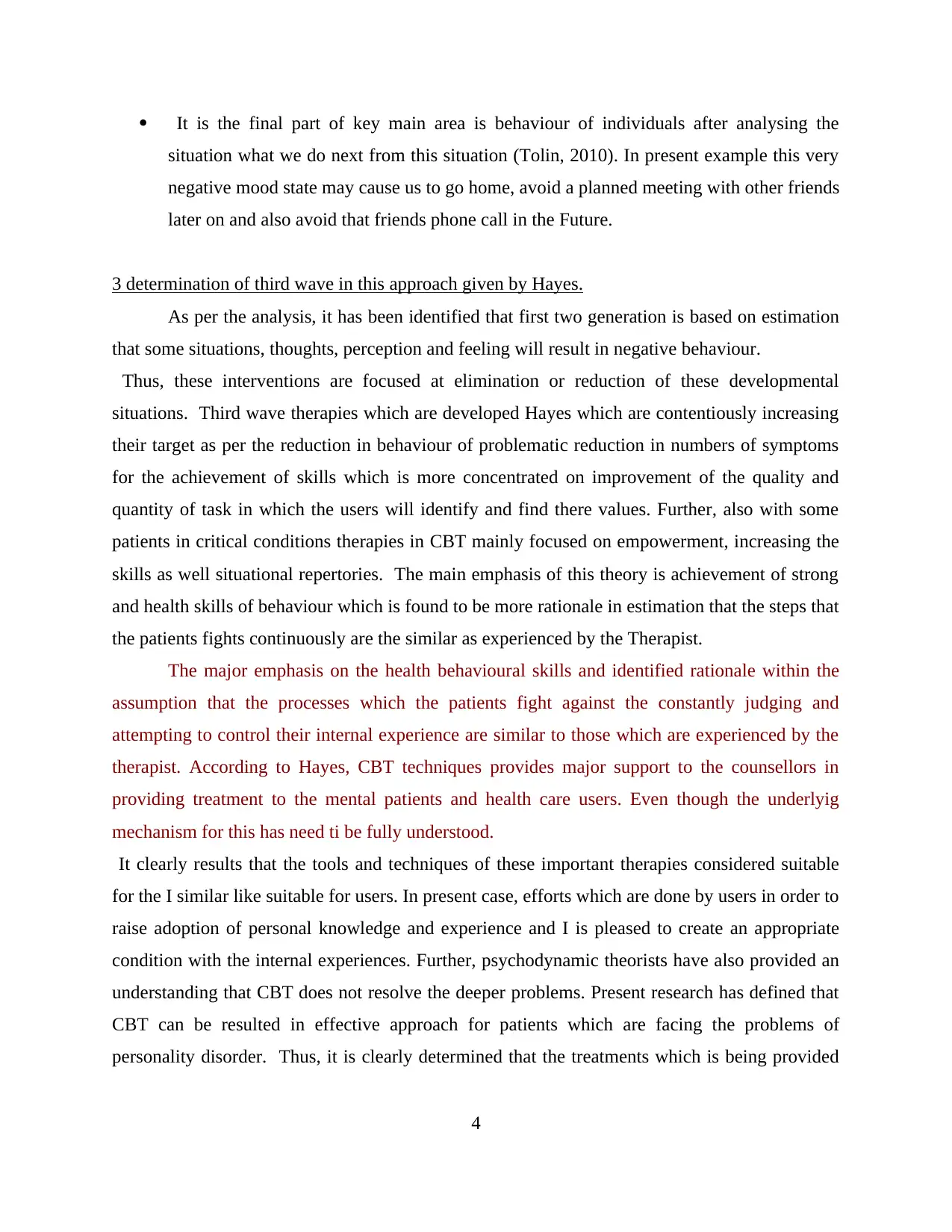
It is the final part of key main area is behaviour of individuals after analysing the
situation what we do next from this situation (Tolin, 2010). In present example this very
negative mood state may cause us to go home, avoid a planned meeting with other friends
later on and also avoid that friends phone call in the Future.
3 determination of third wave in this approach given by Hayes.
As per the analysis, it has been identified that first two generation is based on estimation
that some situations, thoughts, perception and feeling will result in negative behaviour.
Thus, these interventions are focused at elimination or reduction of these developmental
situations. Third wave therapies which are developed Hayes which are contentiously increasing
their target as per the reduction in behaviour of problematic reduction in numbers of symptoms
for the achievement of skills which is more concentrated on improvement of the quality and
quantity of task in which the users will identify and find there values. Further, also with some
patients in critical conditions therapies in CBT mainly focused on empowerment, increasing the
skills as well situational repertories. The main emphasis of this theory is achievement of strong
and health skills of behaviour which is found to be more rationale in estimation that the steps that
the patients fights continuously are the similar as experienced by the Therapist.
The major emphasis on the health behavioural skills and identified rationale within the
assumption that the processes which the patients fight against the constantly judging and
attempting to control their internal experience are similar to those which are experienced by the
therapist. According to Hayes, CBT techniques provides major support to the counsellors in
providing treatment to the mental patients and health care users. Even though the underlyig
mechanism for this has need ti be fully understood.
It clearly results that the tools and techniques of these important therapies considered suitable
for the I similar like suitable for users. In present case, efforts which are done by users in order to
raise adoption of personal knowledge and experience and I is pleased to create an appropriate
condition with the internal experiences. Further, psychodynamic theorists have also provided an
understanding that CBT does not resolve the deeper problems. Present research has defined that
CBT can be resulted in effective approach for patients which are facing the problems of
personality disorder. Thus, it is clearly determined that the treatments which is being provided
4
situation what we do next from this situation (Tolin, 2010). In present example this very
negative mood state may cause us to go home, avoid a planned meeting with other friends
later on and also avoid that friends phone call in the Future.
3 determination of third wave in this approach given by Hayes.
As per the analysis, it has been identified that first two generation is based on estimation
that some situations, thoughts, perception and feeling will result in negative behaviour.
Thus, these interventions are focused at elimination or reduction of these developmental
situations. Third wave therapies which are developed Hayes which are contentiously increasing
their target as per the reduction in behaviour of problematic reduction in numbers of symptoms
for the achievement of skills which is more concentrated on improvement of the quality and
quantity of task in which the users will identify and find there values. Further, also with some
patients in critical conditions therapies in CBT mainly focused on empowerment, increasing the
skills as well situational repertories. The main emphasis of this theory is achievement of strong
and health skills of behaviour which is found to be more rationale in estimation that the steps that
the patients fights continuously are the similar as experienced by the Therapist.
The major emphasis on the health behavioural skills and identified rationale within the
assumption that the processes which the patients fight against the constantly judging and
attempting to control their internal experience are similar to those which are experienced by the
therapist. According to Hayes, CBT techniques provides major support to the counsellors in
providing treatment to the mental patients and health care users. Even though the underlyig
mechanism for this has need ti be fully understood.
It clearly results that the tools and techniques of these important therapies considered suitable
for the I similar like suitable for users. In present case, efforts which are done by users in order to
raise adoption of personal knowledge and experience and I is pleased to create an appropriate
condition with the internal experiences. Further, psychodynamic theorists have also provided an
understanding that CBT does not resolve the deeper problems. Present research has defined that
CBT can be resulted in effective approach for patients which are facing the problems of
personality disorder. Thus, it is clearly determined that the treatments which is being provided
4
⊘ This is a preview!⊘
Do you want full access?
Subscribe today to unlock all pages.

Trusted by 1+ million students worldwide
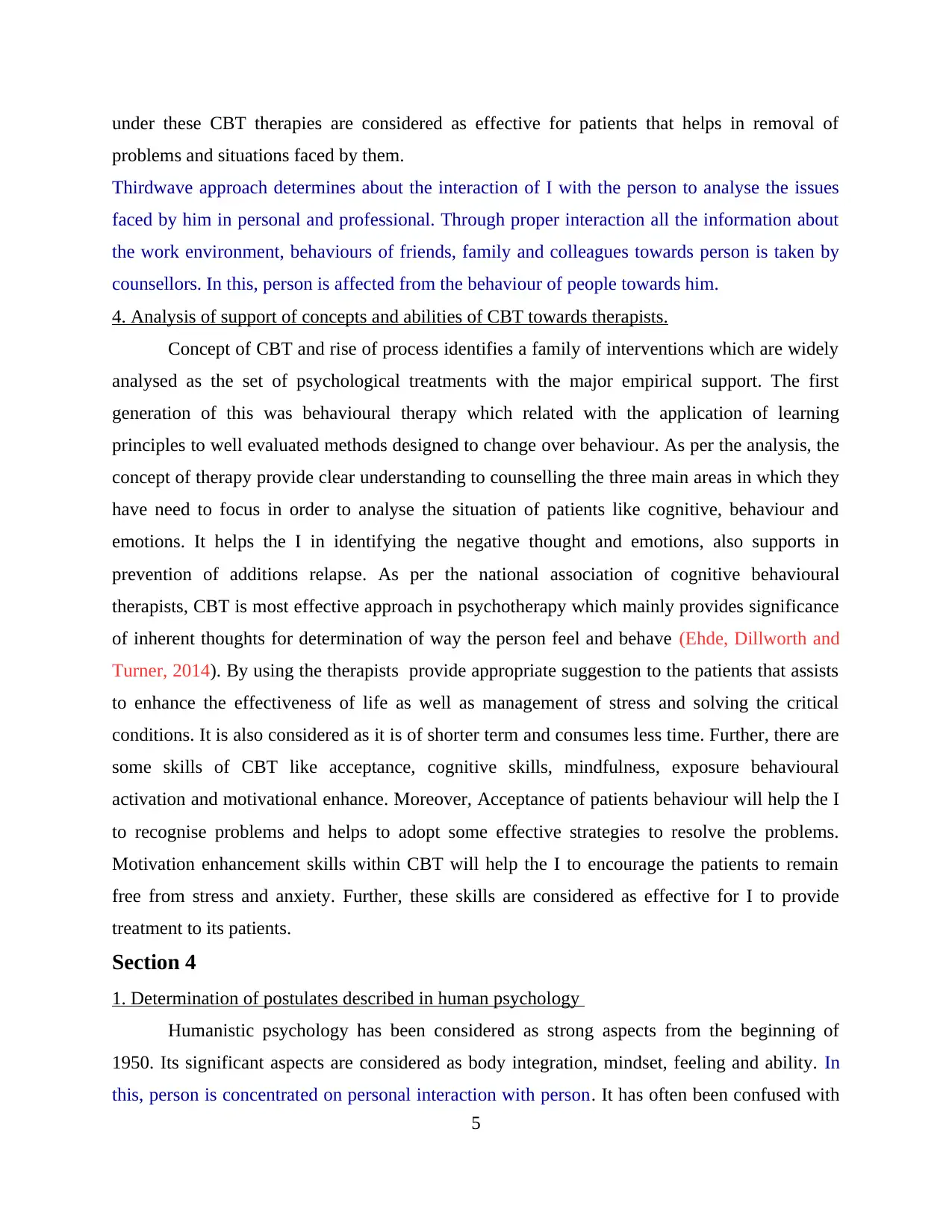
under these CBT therapies are considered as effective for patients that helps in removal of
problems and situations faced by them.
Thirdwave approach determines about the interaction of I with the person to analyse the issues
faced by him in personal and professional. Through proper interaction all the information about
the work environment, behaviours of friends, family and colleagues towards person is taken by
counsellors. In this, person is affected from the behaviour of people towards him.
4. Analysis of support of concepts and abilities of CBT towards therapists.
Concept of CBT and rise of process identifies a family of interventions which are widely
analysed as the set of psychological treatments with the major empirical support. The first
generation of this was behavioural therapy which related with the application of learning
principles to well evaluated methods designed to change over behaviour. As per the analysis, the
concept of therapy provide clear understanding to counselling the three main areas in which they
have need to focus in order to analyse the situation of patients like cognitive, behaviour and
emotions. It helps the I in identifying the negative thought and emotions, also supports in
prevention of additions relapse. As per the national association of cognitive behavioural
therapists, CBT is most effective approach in psychotherapy which mainly provides significance
of inherent thoughts for determination of way the person feel and behave (Ehde, Dillworth and
Turner, 2014). By using the therapists provide appropriate suggestion to the patients that assists
to enhance the effectiveness of life as well as management of stress and solving the critical
conditions. It is also considered as it is of shorter term and consumes less time. Further, there are
some skills of CBT like acceptance, cognitive skills, mindfulness, exposure behavioural
activation and motivational enhance. Moreover, Acceptance of patients behaviour will help the I
to recognise problems and helps to adopt some effective strategies to resolve the problems.
Motivation enhancement skills within CBT will help the I to encourage the patients to remain
free from stress and anxiety. Further, these skills are considered as effective for I to provide
treatment to its patients.
Section 4
1. Determination of postulates described in human psychology
Humanistic psychology has been considered as strong aspects from the beginning of
1950. Its significant aspects are considered as body integration, mindset, feeling and ability. In
this, person is concentrated on personal interaction with person. It has often been confused with
5
problems and situations faced by them.
Thirdwave approach determines about the interaction of I with the person to analyse the issues
faced by him in personal and professional. Through proper interaction all the information about
the work environment, behaviours of friends, family and colleagues towards person is taken by
counsellors. In this, person is affected from the behaviour of people towards him.
4. Analysis of support of concepts and abilities of CBT towards therapists.
Concept of CBT and rise of process identifies a family of interventions which are widely
analysed as the set of psychological treatments with the major empirical support. The first
generation of this was behavioural therapy which related with the application of learning
principles to well evaluated methods designed to change over behaviour. As per the analysis, the
concept of therapy provide clear understanding to counselling the three main areas in which they
have need to focus in order to analyse the situation of patients like cognitive, behaviour and
emotions. It helps the I in identifying the negative thought and emotions, also supports in
prevention of additions relapse. As per the national association of cognitive behavioural
therapists, CBT is most effective approach in psychotherapy which mainly provides significance
of inherent thoughts for determination of way the person feel and behave (Ehde, Dillworth and
Turner, 2014). By using the therapists provide appropriate suggestion to the patients that assists
to enhance the effectiveness of life as well as management of stress and solving the critical
conditions. It is also considered as it is of shorter term and consumes less time. Further, there are
some skills of CBT like acceptance, cognitive skills, mindfulness, exposure behavioural
activation and motivational enhance. Moreover, Acceptance of patients behaviour will help the I
to recognise problems and helps to adopt some effective strategies to resolve the problems.
Motivation enhancement skills within CBT will help the I to encourage the patients to remain
free from stress and anxiety. Further, these skills are considered as effective for I to provide
treatment to its patients.
Section 4
1. Determination of postulates described in human psychology
Humanistic psychology has been considered as strong aspects from the beginning of
1950. Its significant aspects are considered as body integration, mindset, feeling and ability. In
this, person is concentrated on personal interaction with person. It has often been confused with
5
Paraphrase This Document
Need a fresh take? Get an instant paraphrase of this document with our AI Paraphraser
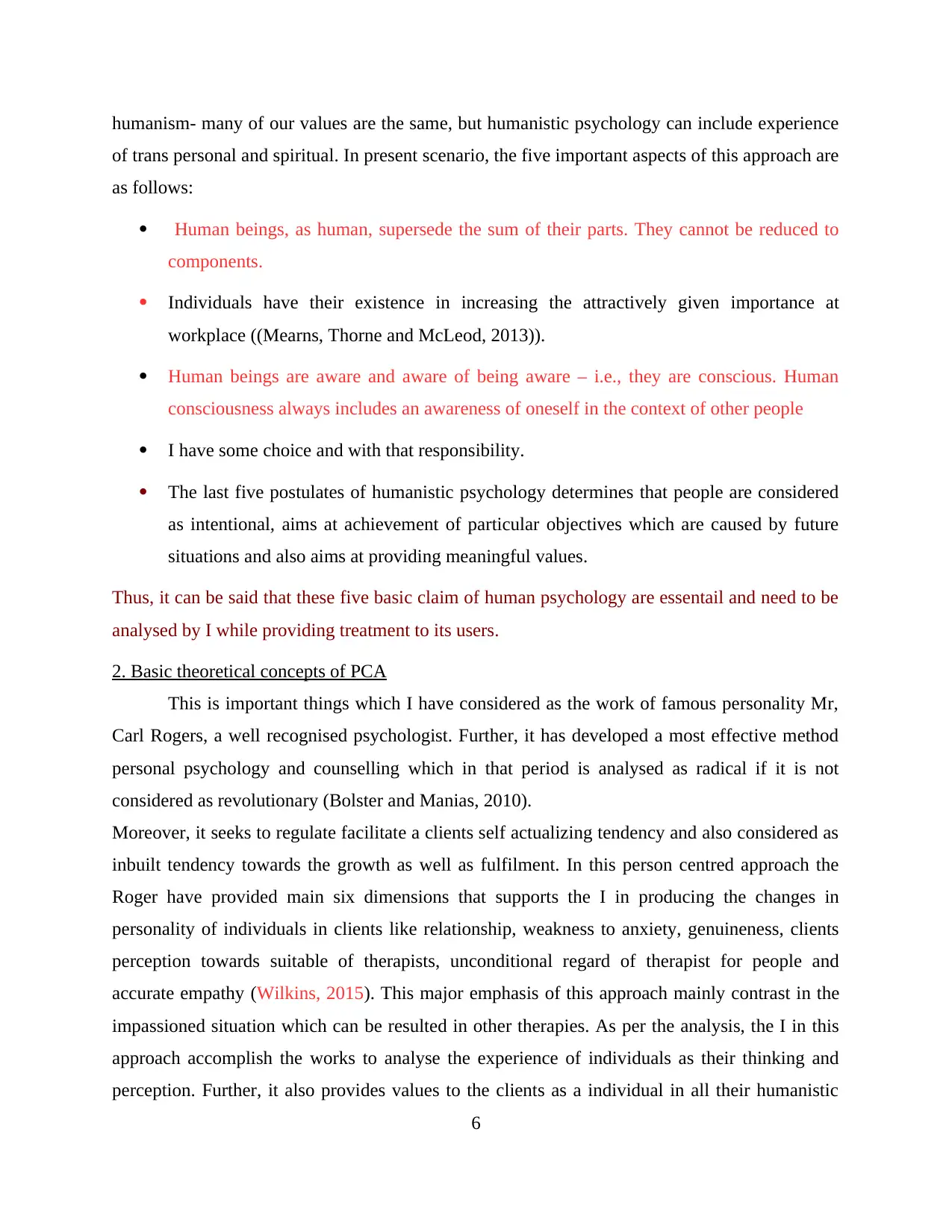
humanism- many of our values are the same, but humanistic psychology can include experience
of trans personal and spiritual. In present scenario, the five important aspects of this approach are
as follows:
Human beings, as human, supersede the sum of their parts. They cannot be reduced to
components.
Individuals have their existence in increasing the attractively given importance at
workplace ((Mearns, Thorne and McLeod, 2013)).
Human beings are aware and aware of being aware – i.e., they are conscious. Human
consciousness always includes an awareness of oneself in the context of other people
I have some choice and with that responsibility.
The last five postulates of humanistic psychology determines that people are considered
as intentional, aims at achievement of particular objectives which are caused by future
situations and also aims at providing meaningful values.
Thus, it can be said that these five basic claim of human psychology are essentail and need to be
analysed by I while providing treatment to its users.
2. Basic theoretical concepts of PCA
This is important things which I have considered as the work of famous personality Mr,
Carl Rogers, a well recognised psychologist. Further, it has developed a most effective method
personal psychology and counselling which in that period is analysed as radical if it is not
considered as revolutionary (Bolster and Manias, 2010).
Moreover, it seeks to regulate facilitate a clients self actualizing tendency and also considered as
inbuilt tendency towards the growth as well as fulfilment. In this person centred approach the
Roger have provided main six dimensions that supports the I in producing the changes in
personality of individuals in clients like relationship, weakness to anxiety, genuineness, clients
perception towards suitable of therapists, unconditional regard of therapist for people and
accurate empathy (Wilkins, 2015). This major emphasis of this approach mainly contrast in the
impassioned situation which can be resulted in other therapies. As per the analysis, the I in this
approach accomplish the works to analyse the experience of individuals as their thinking and
perception. Further, it also provides values to the clients as a individual in all their humanistic
6
of trans personal and spiritual. In present scenario, the five important aspects of this approach are
as follows:
Human beings, as human, supersede the sum of their parts. They cannot be reduced to
components.
Individuals have their existence in increasing the attractively given importance at
workplace ((Mearns, Thorne and McLeod, 2013)).
Human beings are aware and aware of being aware – i.e., they are conscious. Human
consciousness always includes an awareness of oneself in the context of other people
I have some choice and with that responsibility.
The last five postulates of humanistic psychology determines that people are considered
as intentional, aims at achievement of particular objectives which are caused by future
situations and also aims at providing meaningful values.
Thus, it can be said that these five basic claim of human psychology are essentail and need to be
analysed by I while providing treatment to its users.
2. Basic theoretical concepts of PCA
This is important things which I have considered as the work of famous personality Mr,
Carl Rogers, a well recognised psychologist. Further, it has developed a most effective method
personal psychology and counselling which in that period is analysed as radical if it is not
considered as revolutionary (Bolster and Manias, 2010).
Moreover, it seeks to regulate facilitate a clients self actualizing tendency and also considered as
inbuilt tendency towards the growth as well as fulfilment. In this person centred approach the
Roger have provided main six dimensions that supports the I in producing the changes in
personality of individuals in clients like relationship, weakness to anxiety, genuineness, clients
perception towards suitable of therapists, unconditional regard of therapist for people and
accurate empathy (Wilkins, 2015). This major emphasis of this approach mainly contrast in the
impassioned situation which can be resulted in other therapies. As per the analysis, the I in this
approach accomplish the works to analyse the experience of individuals as their thinking and
perception. Further, it also provides values to the clients as a individual in all their humanistic
6
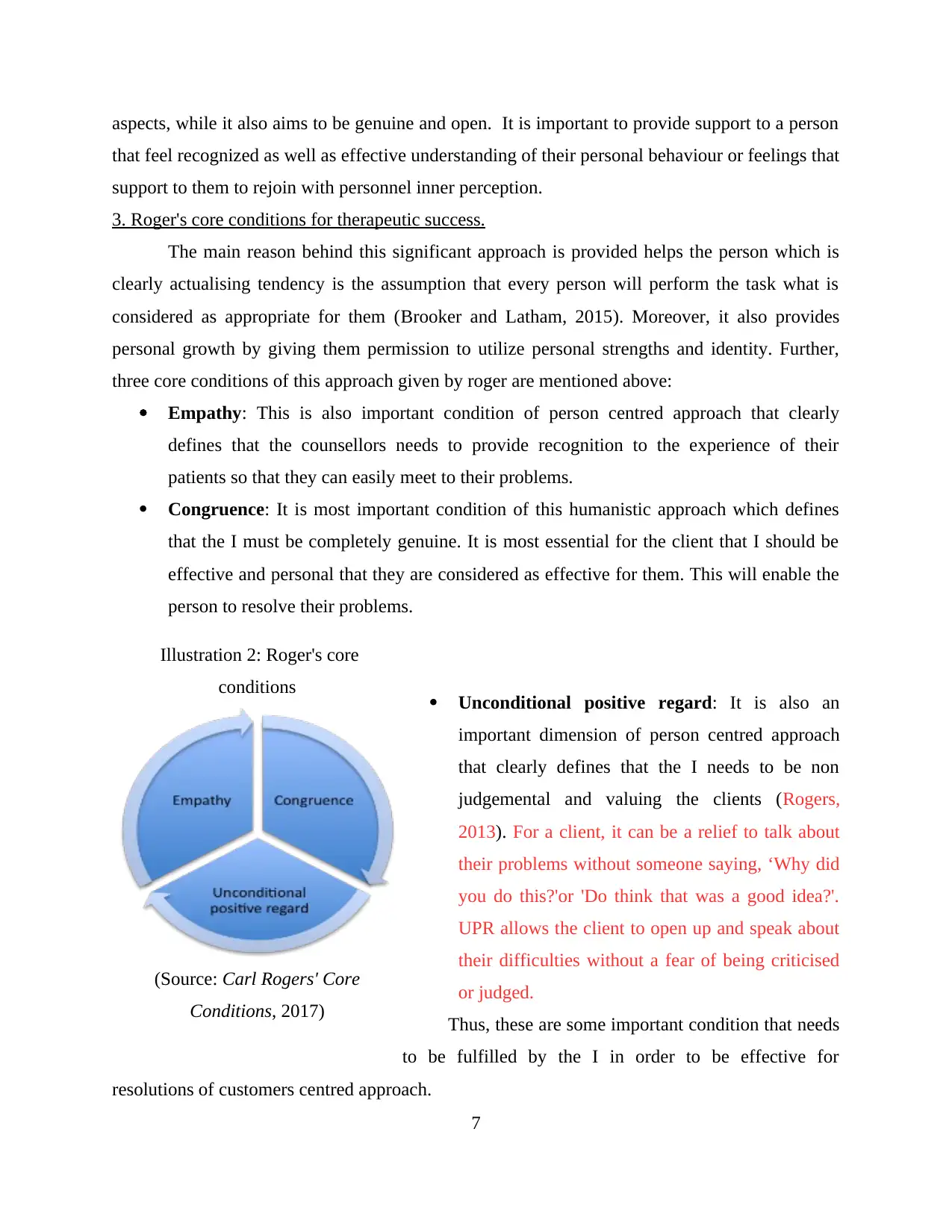
aspects, while it also aims to be genuine and open. It is important to provide support to a person
that feel recognized as well as effective understanding of their personal behaviour or feelings that
support to them to rejoin with personnel inner perception.
3. Roger's core conditions for therapeutic success.
The main reason behind this significant approach is provided helps the person which is
clearly actualising tendency is the assumption that every person will perform the task what is
considered as appropriate for them (Brooker and Latham, 2015). Moreover, it also provides
personal growth by giving them permission to utilize personal strengths and identity. Further,
three core conditions of this approach given by roger are mentioned above:
Empathy: This is also important condition of person centred approach that clearly
defines that the counsellors needs to provide recognition to the experience of their
patients so that they can easily meet to their problems.
Congruence: It is most important condition of this humanistic approach which defines
that the I must be completely genuine. It is most essential for the client that I should be
effective and personal that they are considered as effective for them. This will enable the
person to resolve their problems.
Unconditional positive regard: It is also an
important dimension of person centred approach
that clearly defines that the I needs to be non
judgemental and valuing the clients (Rogers,
2013). For a client, it can be a relief to talk about
their problems without someone saying, ‘Why did
you do this?'or 'Do think that was a good idea?'.
UPR allows the client to open up and speak about
their difficulties without a fear of being criticised
or judged.
Thus, these are some important condition that needs
to be fulfilled by the I in order to be effective for
resolutions of customers centred approach.
7
Illustration 2: Roger's core
conditions
(Source: Carl Rogers' Core
Conditions, 2017)
that feel recognized as well as effective understanding of their personal behaviour or feelings that
support to them to rejoin with personnel inner perception.
3. Roger's core conditions for therapeutic success.
The main reason behind this significant approach is provided helps the person which is
clearly actualising tendency is the assumption that every person will perform the task what is
considered as appropriate for them (Brooker and Latham, 2015). Moreover, it also provides
personal growth by giving them permission to utilize personal strengths and identity. Further,
three core conditions of this approach given by roger are mentioned above:
Empathy: This is also important condition of person centred approach that clearly
defines that the counsellors needs to provide recognition to the experience of their
patients so that they can easily meet to their problems.
Congruence: It is most important condition of this humanistic approach which defines
that the I must be completely genuine. It is most essential for the client that I should be
effective and personal that they are considered as effective for them. This will enable the
person to resolve their problems.
Unconditional positive regard: It is also an
important dimension of person centred approach
that clearly defines that the I needs to be non
judgemental and valuing the clients (Rogers,
2013). For a client, it can be a relief to talk about
their problems without someone saying, ‘Why did
you do this?'or 'Do think that was a good idea?'.
UPR allows the client to open up and speak about
their difficulties without a fear of being criticised
or judged.
Thus, these are some important condition that needs
to be fulfilled by the I in order to be effective for
resolutions of customers centred approach.
7
Illustration 2: Roger's core
conditions
(Source: Carl Rogers' Core
Conditions, 2017)
⊘ This is a preview!⊘
Do you want full access?
Subscribe today to unlock all pages.

Trusted by 1+ million students worldwide
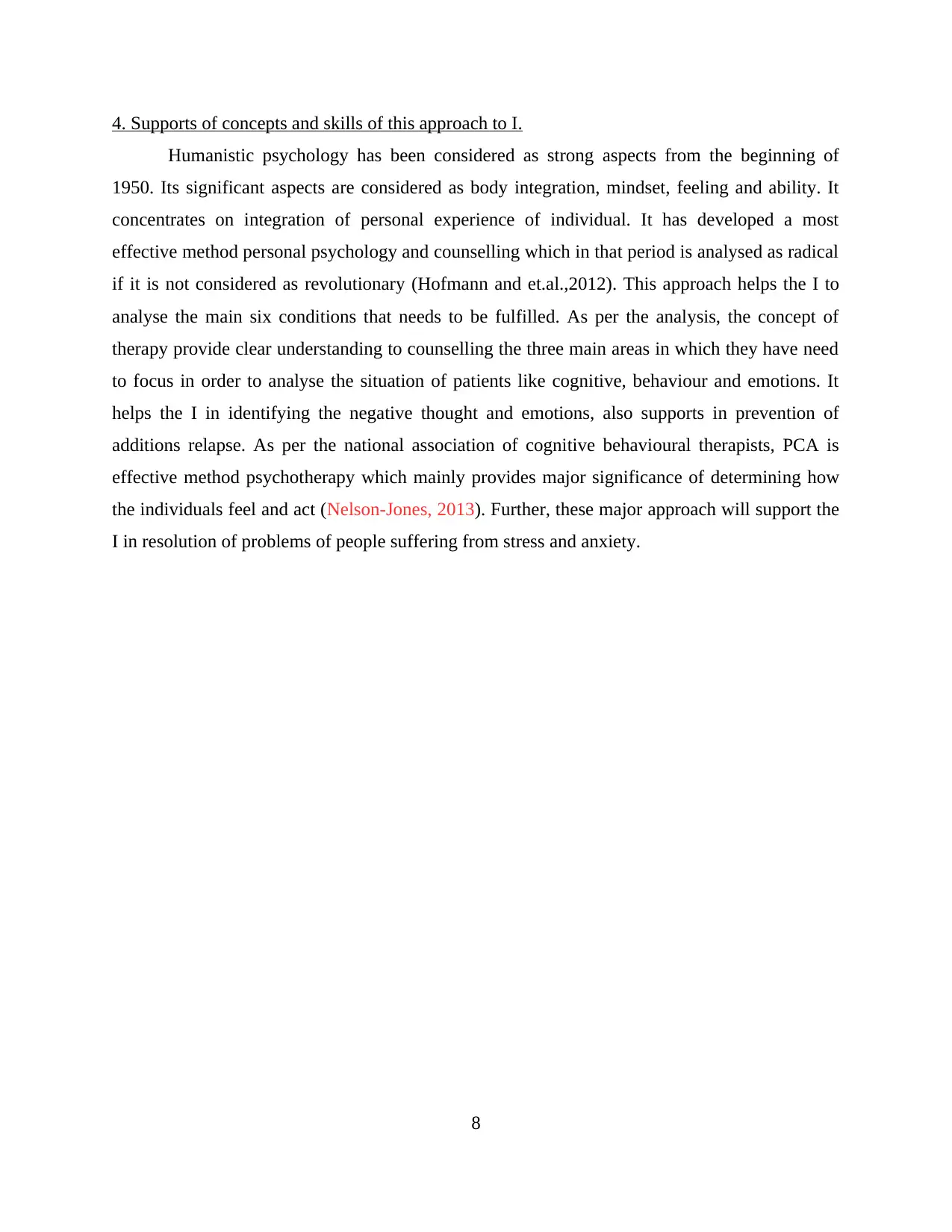
4. Supports of concepts and skills of this approach to I.
Humanistic psychology has been considered as strong aspects from the beginning of
1950. Its significant aspects are considered as body integration, mindset, feeling and ability. It
concentrates on integration of personal experience of individual. It has developed a most
effective method personal psychology and counselling which in that period is analysed as radical
if it is not considered as revolutionary (Hofmann and et.al.,2012). This approach helps the I to
analyse the main six conditions that needs to be fulfilled. As per the analysis, the concept of
therapy provide clear understanding to counselling the three main areas in which they have need
to focus in order to analyse the situation of patients like cognitive, behaviour and emotions. It
helps the I in identifying the negative thought and emotions, also supports in prevention of
additions relapse. As per the national association of cognitive behavioural therapists, PCA is
effective method psychotherapy which mainly provides major significance of determining how
the individuals feel and act (Nelson-Jones, 2013). Further, these major approach will support the
I in resolution of problems of people suffering from stress and anxiety.
8
Humanistic psychology has been considered as strong aspects from the beginning of
1950. Its significant aspects are considered as body integration, mindset, feeling and ability. It
concentrates on integration of personal experience of individual. It has developed a most
effective method personal psychology and counselling which in that period is analysed as radical
if it is not considered as revolutionary (Hofmann and et.al.,2012). This approach helps the I to
analyse the main six conditions that needs to be fulfilled. As per the analysis, the concept of
therapy provide clear understanding to counselling the three main areas in which they have need
to focus in order to analyse the situation of patients like cognitive, behaviour and emotions. It
helps the I in identifying the negative thought and emotions, also supports in prevention of
additions relapse. As per the national association of cognitive behavioural therapists, PCA is
effective method psychotherapy which mainly provides major significance of determining how
the individuals feel and act (Nelson-Jones, 2013). Further, these major approach will support the
I in resolution of problems of people suffering from stress and anxiety.
8
Paraphrase This Document
Need a fresh take? Get an instant paraphrase of this document with our AI Paraphraser
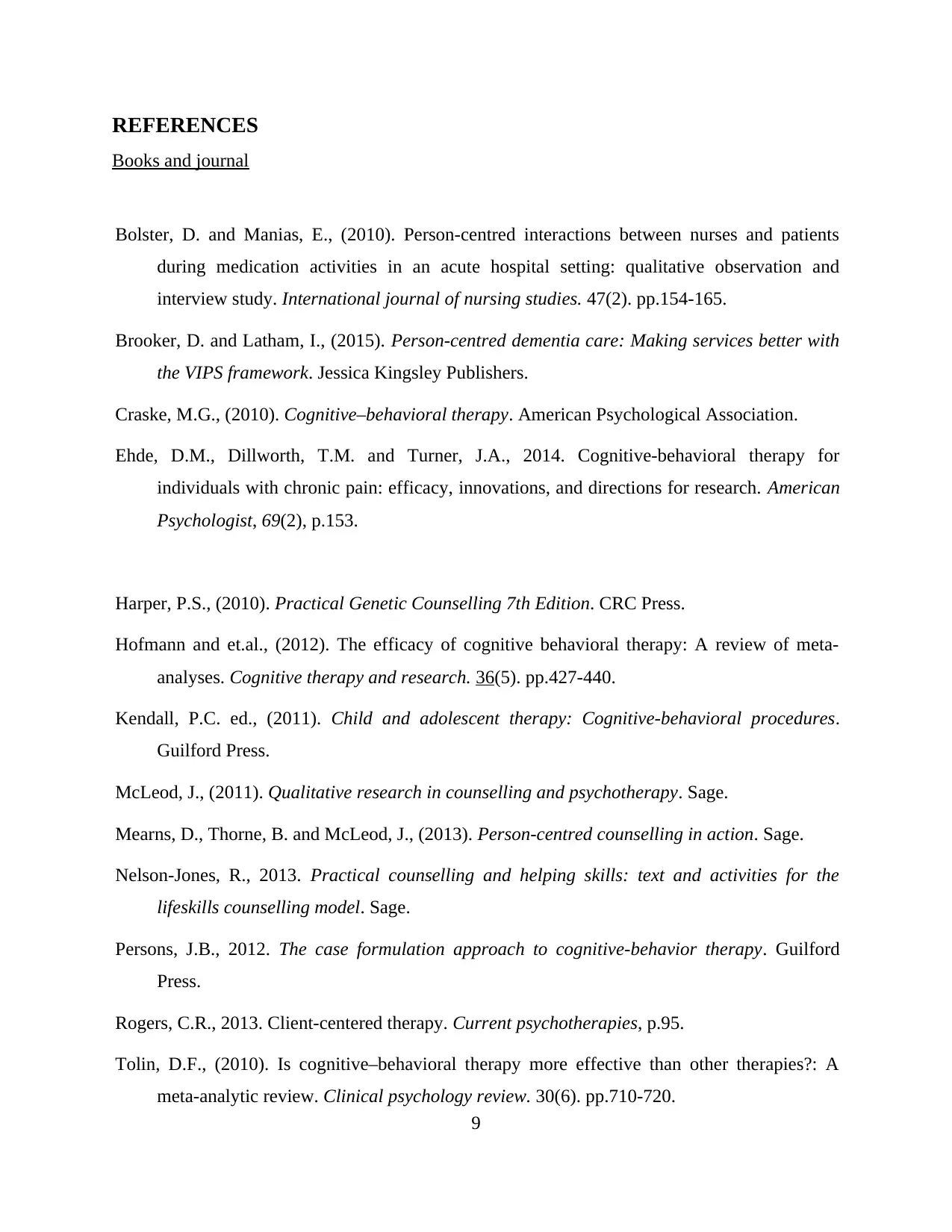
REFERENCES
Books and journal
Bolster, D. and Manias, E., (2010). Person-centred interactions between nurses and patients
during medication activities in an acute hospital setting: qualitative observation and
interview study. International journal of nursing studies. 47(2). pp.154-165.
Brooker, D. and Latham, I., (2015). Person-centred dementia care: Making services better with
the VIPS framework. Jessica Kingsley Publishers.
Craske, M.G., (2010). Cognitive–behavioral therapy. American Psychological Association.
Ehde, D.M., Dillworth, T.M. and Turner, J.A., 2014. Cognitive-behavioral therapy for
individuals with chronic pain: efficacy, innovations, and directions for research. American
Psychologist, 69(2), p.153.
Harper, P.S., (2010). Practical Genetic Counselling 7th Edition. CRC Press.
Hofmann and et.al., (2012). The efficacy of cognitive behavioral therapy: A review of meta-
analyses. Cognitive therapy and research. 36(5). pp.427-440.
Kendall, P.C. ed., (2011). Child and adolescent therapy: Cognitive-behavioral procedures.
Guilford Press.
McLeod, J., (2011). Qualitative research in counselling and psychotherapy. Sage.
Mearns, D., Thorne, B. and McLeod, J., (2013). Person-centred counselling in action. Sage.
Nelson-Jones, R., 2013. Practical counselling and helping skills: text and activities for the
lifeskills counselling model. Sage.
Persons, J.B., 2012. The case formulation approach to cognitive-behavior therapy. Guilford
Press.
Rogers, C.R., 2013. Client-centered therapy. Current psychotherapies, p.95.
Tolin, D.F., (2010). Is cognitive–behavioral therapy more effective than other therapies?: A
meta-analytic review. Clinical psychology review. 30(6). pp.710-720.
9
Books and journal
Bolster, D. and Manias, E., (2010). Person-centred interactions between nurses and patients
during medication activities in an acute hospital setting: qualitative observation and
interview study. International journal of nursing studies. 47(2). pp.154-165.
Brooker, D. and Latham, I., (2015). Person-centred dementia care: Making services better with
the VIPS framework. Jessica Kingsley Publishers.
Craske, M.G., (2010). Cognitive–behavioral therapy. American Psychological Association.
Ehde, D.M., Dillworth, T.M. and Turner, J.A., 2014. Cognitive-behavioral therapy for
individuals with chronic pain: efficacy, innovations, and directions for research. American
Psychologist, 69(2), p.153.
Harper, P.S., (2010). Practical Genetic Counselling 7th Edition. CRC Press.
Hofmann and et.al., (2012). The efficacy of cognitive behavioral therapy: A review of meta-
analyses. Cognitive therapy and research. 36(5). pp.427-440.
Kendall, P.C. ed., (2011). Child and adolescent therapy: Cognitive-behavioral procedures.
Guilford Press.
McLeod, J., (2011). Qualitative research in counselling and psychotherapy. Sage.
Mearns, D., Thorne, B. and McLeod, J., (2013). Person-centred counselling in action. Sage.
Nelson-Jones, R., 2013. Practical counselling and helping skills: text and activities for the
lifeskills counselling model. Sage.
Persons, J.B., 2012. The case formulation approach to cognitive-behavior therapy. Guilford
Press.
Rogers, C.R., 2013. Client-centered therapy. Current psychotherapies, p.95.
Tolin, D.F., (2010). Is cognitive–behavioral therapy more effective than other therapies?: A
meta-analytic review. Clinical psychology review. 30(6). pp.710-720.
9
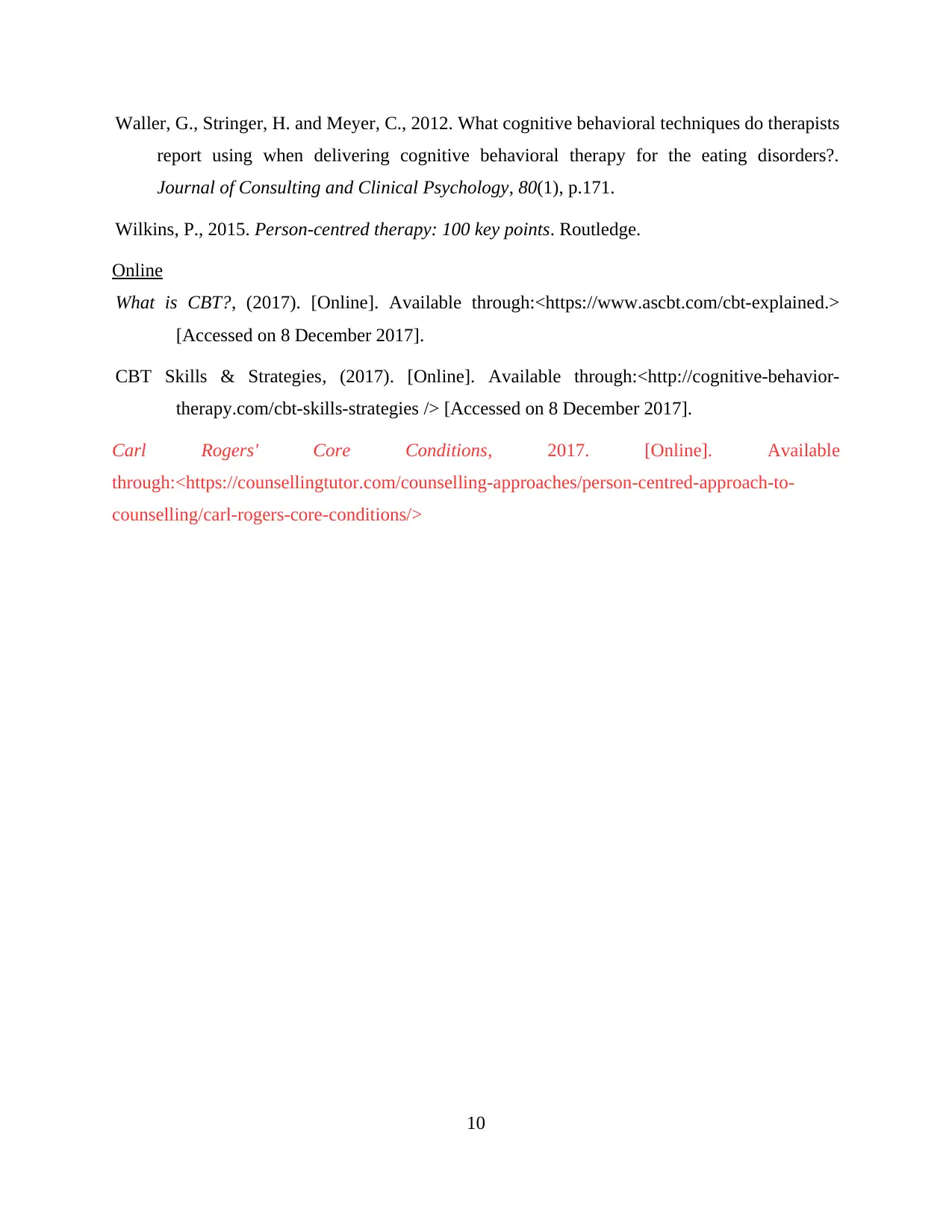
Waller, G., Stringer, H. and Meyer, C., 2012. What cognitive behavioral techniques do therapists
report using when delivering cognitive behavioral therapy for the eating disorders?.
Journal of Consulting and Clinical Psychology, 80(1), p.171.
Wilkins, P., 2015. Person-centred therapy: 100 key points. Routledge.
Online
What is CBT?, (2017). [Online]. Available through:<https://www.ascbt.com/cbt-explained.>
[Accessed on 8 December 2017].
CBT Skills & Strategies, (2017). [Online]. Available through:<http://cognitive-behavior-
therapy.com/cbt-skills-strategies /> [Accessed on 8 December 2017].
Carl Rogers' Core Conditions, 2017. [Online]. Available
through:<https://counsellingtutor.com/counselling-approaches/person-centred-approach-to-
counselling/carl-rogers-core-conditions/>
10
report using when delivering cognitive behavioral therapy for the eating disorders?.
Journal of Consulting and Clinical Psychology, 80(1), p.171.
Wilkins, P., 2015. Person-centred therapy: 100 key points. Routledge.
Online
What is CBT?, (2017). [Online]. Available through:<https://www.ascbt.com/cbt-explained.>
[Accessed on 8 December 2017].
CBT Skills & Strategies, (2017). [Online]. Available through:<http://cognitive-behavior-
therapy.com/cbt-skills-strategies /> [Accessed on 8 December 2017].
Carl Rogers' Core Conditions, 2017. [Online]. Available
through:<https://counsellingtutor.com/counselling-approaches/person-centred-approach-to-
counselling/carl-rogers-core-conditions/>
10
⊘ This is a preview!⊘
Do you want full access?
Subscribe today to unlock all pages.

Trusted by 1+ million students worldwide
1 out of 12
Related Documents
Your All-in-One AI-Powered Toolkit for Academic Success.
+13062052269
info@desklib.com
Available 24*7 on WhatsApp / Email
![[object Object]](/_next/static/media/star-bottom.7253800d.svg)
Unlock your academic potential
Copyright © 2020–2025 A2Z Services. All Rights Reserved. Developed and managed by ZUCOL.




